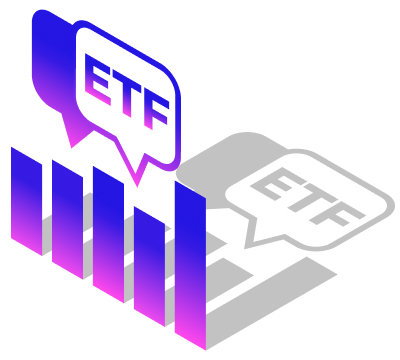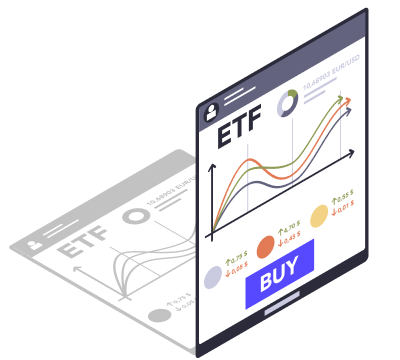Are you an ETF trader looking to learn ETF trading strategies that will help increase your profit potential? This guide has all the information you need.
In This Guide
ETF Trading Strategies for Beginners
What Are ETFs?

ETFs – exchange-traded funds – are products or securities that track indices, commodities, or other assets in a stock exchange. They are traded like regular stocks, and in one way or the other, ETFs are similar to mutual funds. The only thing that differentiates an ETF from a mutual fund is that mutual funds are traded based on their prices at the end of a trading session, whereas ETFs are or can be traded throughout a trading session in a stock exchange. Investors interested in ETFs or brokerage mutual funds can access them through various financial institutions or brokerage firms.
We consider ETF trading an excellent option for beginner investors in the trading industry. This is because it provides a wide range of equities and indices, making ETFs in general diversified assets.
ETFs are also best for budget-conscious traders and investors. You can get way cheaper access to a sector that seems to be challenging to trade. For example, if a trader wishes to buy gold, they can either purchase it as a bar, coin, or trade gold futures contract.
This method of trading gold is relatively expensive and time-consuming, which limits the low-budget investors. However, when you decide to trade gold as ETFs, you are only going to buy the shares of the gold rather than owning it.
ETF Trading Strategies

Getting started towards successful ETF trading not only requires the best ETF providers in the UK, but you will also have to arm yourself with ETF trading strategies. The last thing you want is to face the ETF trading markets without a strategy and end up losing your initial investment funds.
So without further ado, let’s dive right into the significant ETF trading strategies.
- Swing ETF Trading
Swing trading is an ETF trading strategy that has become popular among short-term traders. It involves capturing the short-term price movements of ETF assets, and the trades usually last between a few days to weeks.
Swing trading can bring about good profits if you observe the chart patterns carefully. Knowing where to place entry and exit points will also benefit your ETF trading activities.
The best approach for swing trading strategy is that you need to identify an ETF trend that has a strong momentum. You can then stick to and keep track of the momentum in order to make the best move immediately when it starts to fade, whether in a downward or upward direction.
- Seasonal ETF Trading Strategy
Also known as sector rotation strategy, this method of approaching ETF trading is easy to master, which could be an excellent choice for newbies. However, this strategy only applies when the markets are favourable during specific seasons.
For instance, the price of ETF assets varies based on demand and season. You will find that there are assets that their prices go up during summer and reduce during winter. In this case, you will take advantage of the seasons and speculate on assets that will favour your trade.
We advise you to conduct thorough research before applying this strategy. Look back at the previous years’ asset prices and observe their behaviours before you decide to open a position.
- Short-Selling ETF Strategy
Short-selling is a common trading strategy that benefits many ETF traders. It usually involves selling an ETF for a higher price and then repurchasing it at a reduced price. You will benefit from the difference between the buying and selling price.
In most cases, ETF traders using this strategy will borrow the ETFs that they use to trade from their brokers. This makes the short-selling strategy riskier than other strategies but can earn you lots of profits with extensive market research.
- Overbought and Oversold Strategy
This is another risky strategy that you need to be careful with. This means that you must apply technical analysis in order to successfully execute this ETF trading strategy.
ETF traders need to identify the overbought and oversold levels of ETFs and trade when they see an opportunity. Overbought levels mean that ETFs’ prices are increasing above their current values, whereas oversold means the prices are declining below the current value.
You can make profits from this strategy by identifying when ETFs are oversold in order to buy them and when they are overbought to sell. Through the use of price charts and indicators to identify price patterns, you can find this strategy beneficial.
- Hedging
Traders can hedge their portfolios using ETFs to protect them against downward risks. In case your portfolio is affected by market declines, the profits made from short ETF positions will help you offset your declines in the portfolio.
In case the market advances and your portfolio improves, your gains will be capped. These profits will then be used to offset any losses made in short ETF positions. Hedging strategy is pretty straightforward, and beginners can gain profits from it.
How To Trade ETFs
ETFs can be like a basket of opportunities, but remember, they’re not immune to market shifts. Just as the seasons change, so can the value of your ETF investments. Before diving in, take time to explore what’s inside the basket – understand the assets, their track record, and potential pitfalls.
Think of ETFs like a treasure map; you want to ensure you’re not led astray. Watch out for hidden costs and tracking errors, as these can be the dragons on your path to returns. A careful approach to ETF investing is your compass through the market’s wilderness, helping you navigate potential risks while optimising your investment journey.

ETFs are a good trading option for individuals looking to diversify their portfolios across various financial assets. However, many traders want to try their luck in this activity, but are they actually ready to manage an ETF position?
Below are the steps to follow for you to trade ETFs. These, together with ETF trading strategies, will improve your chances of earning profits.
- Learn ETF Trading
To start trading ETFs, you must be knowledgeable about ETF trading. Understand all the types of ETFs and how much it takes to trade those ETFs. This is so that you can plan and budget for it before giving it a try.
- Choose a Broker
You then need the best ETF trading broker that meets your ETF trading demands. You can take a look at our guide on the best ETF brokers in the UK for excellent recommendations. Trading with the best broker will not limit your strategy hence make you trade across diverse markets.
- Open a Trading Account
Once you have found your ETF broker of choice, you can either choose to test it using a demo account or dive right into the real markets with the live trading account. Every ETF broker has its requirements for account opening and trading. Therefore make sure you understand all these requirements before you create an account.
- Choose a Strategy
Once you have made your deposit and accessed the financial markets you wish to trade, you will have to choose an ETF strategy. Go for a strategy that you fully understand and can analyse markets with. You can then open a position by choosing your entry and exit points.
Trading ETFs with a good broker and strategy is not a sure-fire way of making profits. Unfortunately, this means that you can also lose, even after conducting extensive market analysis. Remember, market analysis is never 100% accurate, so you have to be prepared with risk management orders in case a loss occurs.
Final Thoughts
ETF trading can be lucrative with proper market analysis and strategy. The above ETF trading strategies will help you manage your ETF positions, whether you are a beginner or expert trader. So, take your time and understand how they work and when to apply them. You should also choose the best broker for ETF trading and start hoping for the best trading results.




If you want a broker with a large range of instruments available to trade, XTB may be more suitable. AvaTrade and XTB offer similar trading methods.
Which broker is more reliable?
You can determine a broker’s reliability & trustworthiness by looking at eight factors:
Who are they regulated by?
How long have they been around?
Do they hold your money in a separate bank account?
Have they been fined or penalized in the last five years?
The popularity of their service/website
Are they publicly listed?
Where are they located?